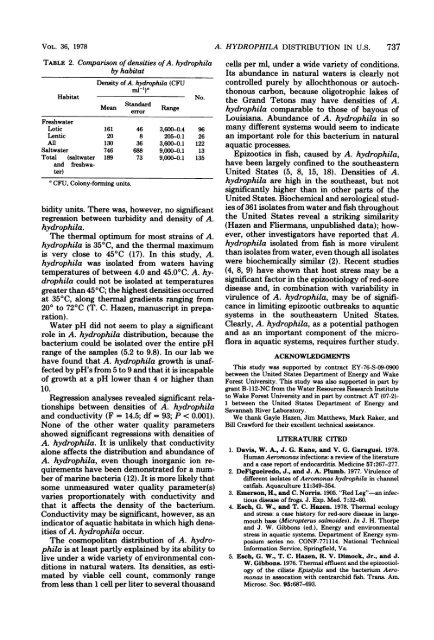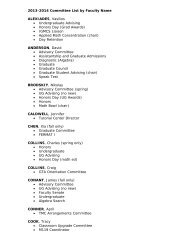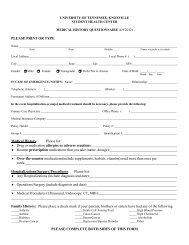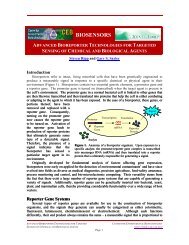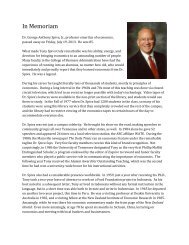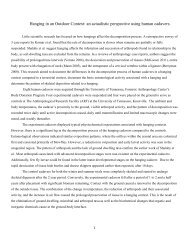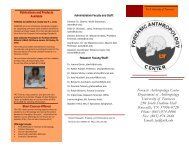Prevalence and Distribution of Aeromonas hydrophila in the United ...
Prevalence and Distribution of Aeromonas hydrophila in the United ...
Prevalence and Distribution of Aeromonas hydrophila in the United ...
- No tags were found...
You also want an ePaper? Increase the reach of your titles
YUMPU automatically turns print PDFs into web optimized ePapers that Google loves.
VOL. 36, 1978 A. HYDROPHILA DISTRIBUTION IN U.S. 737TABLE 2. Comparison <strong>of</strong> densities <strong>of</strong> A. <strong>hydrophila</strong>by habitatDensity <strong>of</strong> A. <strong>hydrophila</strong> (CFUMI-I)aHabitatNo.Mean St<strong>and</strong>ard RangeerrorFreshwaterLotic 161 46 3,600-0.4 96Lentic 20 8 205-0.1 26All 130 36 3,600-0.1 122Saltwater 746 688 9,000-0.1 13Total (saltwater 189 73 9,000-0.1 135<strong>and</strong> freshwater)CFU, Colony-form<strong>in</strong>g units.bidity units. There was, however, no significantregression between turbidity <strong>and</strong> density <strong>of</strong> A.<strong>hydrophila</strong>.The <strong>the</strong>rmal optimum for most stra<strong>in</strong>s <strong>of</strong> A.<strong>hydrophila</strong> is 35°C, <strong>and</strong> <strong>the</strong> <strong>the</strong>rmal maximumis very close to 450C (17). In this study, A.<strong>hydrophila</strong> was isolated from waters hav<strong>in</strong>gtemperatures <strong>of</strong> between 4.0 <strong>and</strong> 45.00C. A. <strong>hydrophila</strong>could not be isolated at temperaturesgreater than 450C; <strong>the</strong> highest densities occurredat 350C, along <strong>the</strong>rmal gradients rang<strong>in</strong>g from200 to 720C (T. C. Hazen, manuscript <strong>in</strong> preparation).Water pH did not seem to play a significantrole <strong>in</strong> A. <strong>hydrophila</strong> distribution, because <strong>the</strong>bacterium could be isolated over <strong>the</strong> entire pHrange <strong>of</strong> <strong>the</strong> samples (5.2 to 9.8). In our lab wehave found that A. <strong>hydrophila</strong> growth is unaffectedby pH's from 5 to 9 <strong>and</strong> that it is <strong>in</strong>capable<strong>of</strong> growth at a pH lower than 4 or higher than10.Regression analyses revealed significant relationshipsbetween densities <strong>of</strong> A. <strong>hydrophila</strong><strong>and</strong> conductivity (F = 14.5; df = 93; P < 0.001).None <strong>of</strong> <strong>the</strong> o<strong>the</strong>r water quality parametersshowed significant regressions with densities <strong>of</strong>A. <strong>hydrophila</strong>. It is unlikely that conductivityalone affects <strong>the</strong> distribution <strong>and</strong> abundance <strong>of</strong>A. <strong>hydrophila</strong>, even though <strong>in</strong>organic ion requirementshave been demonstrated for a number<strong>of</strong> mar<strong>in</strong>e bacteria (12). It is more likely thatsome unmeasured water quality parameter(s)varies proportionately with conductivity <strong>and</strong>that it affects <strong>the</strong> density <strong>of</strong> <strong>the</strong> bacterium.Conductivity may be significant, however, as an<strong>in</strong>dicator <strong>of</strong> aquatic habitats <strong>in</strong> which high densities<strong>of</strong> A. <strong>hydrophila</strong> occur.The cosmopolitan distribution <strong>of</strong> A. <strong>hydrophila</strong>is at least partly expla<strong>in</strong>ed by its ability tolive under a wide variety <strong>of</strong> environmental conditions<strong>in</strong> natural waters. Its densities, as estimatedby viable cell count, commonly rangefrom less than 1 cell per liter to several thous<strong>and</strong>cells per ml, under a wide variety <strong>of</strong> conditions.Its abundance <strong>in</strong> natural waters is clearly notcontrolled purely by allochthonous or autochthonouscarbon, because oligotrophic lakes <strong>of</strong><strong>the</strong> Gr<strong>and</strong> Tetons may have densities <strong>of</strong> A.<strong>hydrophila</strong> comparable to those <strong>of</strong> bayous <strong>of</strong>Louisiana. Abundance <strong>of</strong> A. <strong>hydrophila</strong> <strong>in</strong> somany different systems would seem to <strong>in</strong>dicatean important role for this bacterium <strong>in</strong> naturalaquatic processes.Epizootics <strong>in</strong> fish, caused by A. <strong>hydrophila</strong>,have been largely conf<strong>in</strong>ed to <strong>the</strong> sou<strong>the</strong>astern<strong>United</strong> States (5, 8, 15, 18). Densities <strong>of</strong> A.<strong>hydrophila</strong> are high <strong>in</strong> <strong>the</strong> sou<strong>the</strong>ast, but notsignificantly higher than <strong>in</strong> o<strong>the</strong>r parts <strong>of</strong> <strong>the</strong><strong>United</strong> States. Biochemical <strong>and</strong> serological studies<strong>of</strong> 361 isolates from water <strong>and</strong> fish throughout<strong>the</strong> <strong>United</strong> States reveal a strik<strong>in</strong>g similarity(Hazen <strong>and</strong> Fliermans, unpublished data); however,o<strong>the</strong>r <strong>in</strong>vestigators have reported that A.<strong>hydrophila</strong> isolated from fish is more virulentthan isolates from water, even though all isolateswere biochemically similar (2). Recent studies(4, 8, 9) have shown that host stress may be asignificant factor <strong>in</strong> <strong>the</strong> epizootiology <strong>of</strong> red-soredisease <strong>and</strong>, <strong>in</strong> comb<strong>in</strong>ation with variability <strong>in</strong>virulence <strong>of</strong> A. <strong>hydrophila</strong>, may be <strong>of</strong> significance<strong>in</strong> limit<strong>in</strong>g epizootic outbreaks to aquaticsystems <strong>in</strong> <strong>the</strong> sou<strong>the</strong>astern <strong>United</strong> States.Clearly, A. <strong>hydrophila</strong>, as a potential pathogen<strong>and</strong> as an important component <strong>of</strong> <strong>the</strong> micr<strong>of</strong>lora<strong>in</strong> aquatic systems, requires fur<strong>the</strong>r study.ACKNOWLEDGMENTSThis study was supported by contract EY-76-S-09-0900between <strong>the</strong> <strong>United</strong> States Department <strong>of</strong> Energy <strong>and</strong> WakeForest University. This study was also supported <strong>in</strong> part bygrant B-112-NC from <strong>the</strong> Water Resources Research Instituteto Wake Forest University <strong>and</strong> <strong>in</strong> part by contract AT (07-2)-1 between <strong>the</strong> <strong>United</strong> States Department <strong>of</strong> Energy <strong>and</strong>Savannah River Laboratory.We thank Gayle Hazen, Jim Mat<strong>the</strong>ws, Mark Raker, <strong>and</strong>Bill Crawford for <strong>the</strong>ir excellent technical assistance.LITERATURE CITED1. Davis, W. A., J. G. Kane, <strong>and</strong> V. G. Garagusi. 1978.Human <strong>Aeromonas</strong> <strong>in</strong>fections: a review <strong>of</strong> <strong>the</strong> literature<strong>and</strong> a case report <strong>of</strong> endocarditis. Medic<strong>in</strong>e 57:267-277.2. DeFigueiredo, J., <strong>and</strong> J. A. Plumb. 1977. Virulence <strong>of</strong>different isolates <strong>of</strong> <strong>Aeromonas</strong> <strong>hydrophila</strong> <strong>in</strong> channelcatfish. Aquaculture 11:349-354.3. Emerson, H., <strong>and</strong> C. Norris. 1905. "Red Leg"-an <strong>in</strong>fectiousdisease <strong>of</strong> frogs. J. Exp. Med. 7:32-60.4. Esch, G. W., <strong>and</strong> T. C. Hazen. 1978. Thermal ecology<strong>and</strong> stress: a case history for red-sore disease <strong>in</strong> largemouthbass (Micropterus salmoides). In J. H. Thorpe<strong>and</strong> J. W. Gibbons (ed.), Energy <strong>and</strong> environmentalstress <strong>in</strong> aquatic systems. Department <strong>of</strong> Energy symposiumseries no. CONF-771114. National TechnicalInformation Service, Spr<strong>in</strong>gfield, Va.5. Esch, G. W., T. C. Hazen, R. V. Dimock, Jr., <strong>and</strong> J.W. Gibbons. 1976. Thermal effluent <strong>and</strong> <strong>the</strong> epizootiology<strong>of</strong> <strong>the</strong> ciliate Epistylis <strong>and</strong> <strong>the</strong> bacterium <strong>Aeromonas</strong><strong>in</strong> assocation with centrarchid fish. Trans. Am.Microsc. Soc. 95:687-693.


